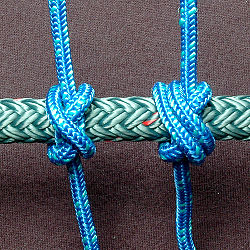The Constrictor knot is appropriate for situations where secure temporary or semi-permanent binding is needed. Made with small-stuff it is especially effective, as the binding force is concentrated over a smaller area. Tied over soft material, such as the neck of a bag, use hard stiff cord. Tied over a hard surface, use soft stretchy line. The Constrictor knot's severe bite, which makes it so effective, can damage or disfigure items it is tied around.[3] To exert extreme tension on the knot without injuring the hands fashion handles for the ends using Marlinespike hitches made around two rods.
Constrictor knots can be for used for temporarily binding the fibres of a rope or strand end together while splicing or when cutting to length and before properly whipping the ends. Constrictor knots can also be quite effective as improvised hose clamps or cable ties. Noted master-rigger Brion Toss says of the Constrictor, "To know the knot is to constantly find uses for it...."

Left: Constrictor knot
Right: Double constrictor knot
Tying the Double constrictor knot
If a stronger and even more secure knot is required an extra riding turn can be added to the basic knot to form a Double constrictor knot. It is particularly useful when tying the knot with very slippery twine, especially when waxed. Adding more than one extra riding turn does not add to its security and makes the knot more difficult to tighten evenly.

- Make a turn around the object and bring the working end back over the standing part.
- Make a second turn following the same path as the first
- Pass the working end over the standing part, then thread it back under the standing part and both riding turns, forming an overhand knot under two riding turns.
- Be sure the ends emerge between the turns as shown. The Double constrictor may require more careful dressing to distribute the tension throughout the knot. After working up fairly tight, pull firmly on the ends to finish.